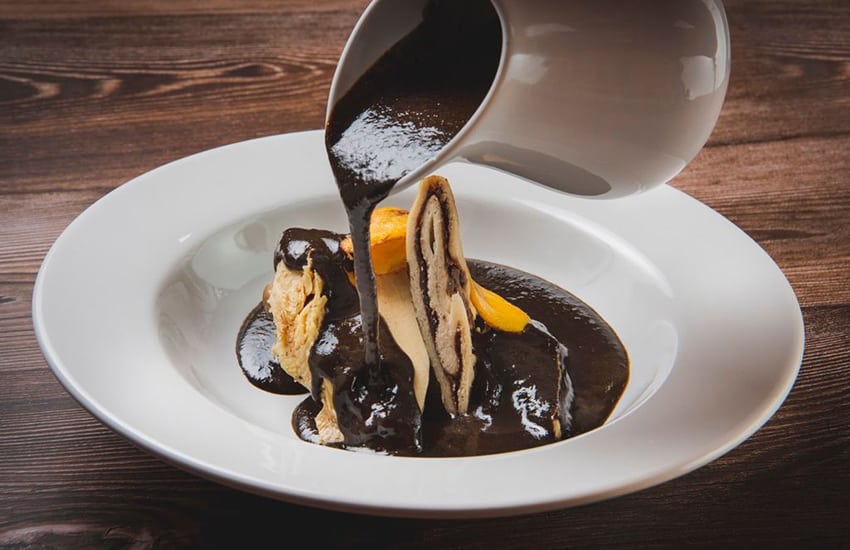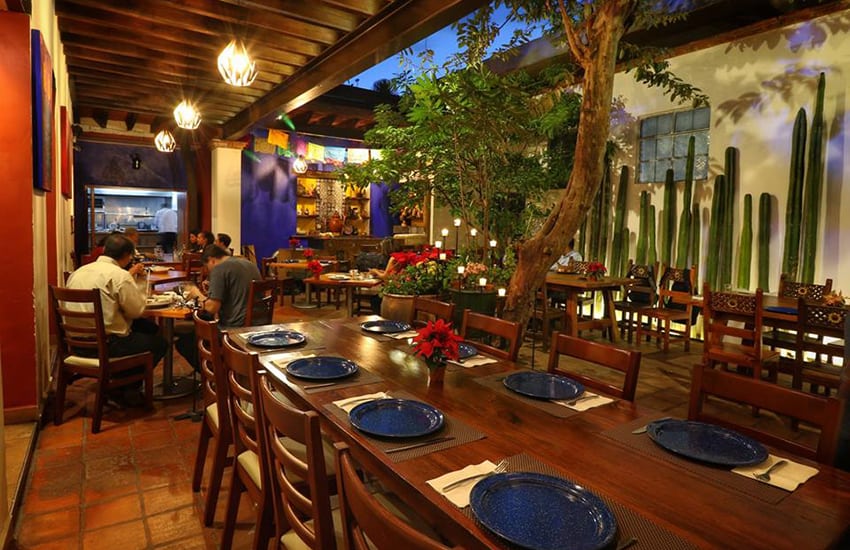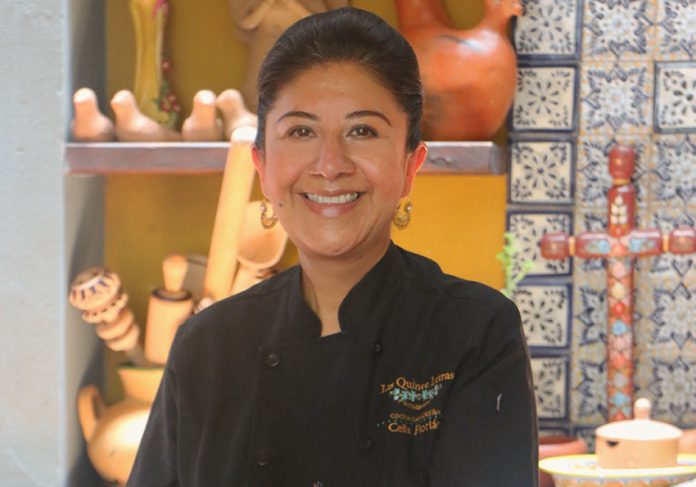Celia Florián sums up Oaxacan cuisine with the words mole, corn and mezcal. But the cuisine and the culture behind it are a complicated tapestry of local and seasonal ingredients that distinguish dishes among the many small valleys of this mountainous state.
Florián is the owner and inspiration behind the Las Quince Letras restaurant, which she opened with husband Fidel Méndez in 1992 in the center of Oaxaca city. It serves dishes from all over the state, but its signature dish is the mole negro that she grew up with.
“Cooking is for me an encounter with myself,” Florián says. “It has been my refuge; it is my home and it will continue to be my everything.”
That passion for cooking began early in life. Born into a rural farm family in the La Ciénaga community of Zimatlán de Álvarez, her early childhood revolved around the cultivation and preparation of food.
Her culinary foundation is the work she did with her mother and grandmother, learning tasks such as prepping vegetables, making tortillas and even churning butter.

“Here in Oaxaca, we eat well as families because of the variety of ingredients there are. The cuisine is exquisite, very healthy because of the plants and other ingredients that the earth provides. They give the dishes their distinctive flavors.”
The family moved to the city of Oaxaca when she was still in primary school. As an adult, she had a steady job working at a bank, but her love for the cuisine of her childhood led her to take the plunge and open Las Quince Letras, a lifelong project of bringing the home cooking of Oaxaca’s kitchens to an appreciative audience.
Florián is not a trained chef. Her knowledge comes from her personal experience and her contacts with many, many home cooks all over the state. She did take some classes in restaurant operations but tries to keep cooking techniques as close to the original as possible. This includes an aversion to exact measurements and preferring to cook by sight, feel and experience.
“You need to cook with your own hands,” she says. However, traditional wood fires are out because of city regulations.
She promotes quality, healthy, locally produced traditional food. Country cooking, she says, means depending on what is available locally and almost never using prepackaged items. Cooks like her grandmother use few oils and fats. Florián follows this example.
She finds that avoiding the fat does not mean lessening the flavor. “In fact, they taste more elegant,” she says.
Las Quince Letras (The 15 Letters) has been in the same location since it opened 28 years ago.
The name is taken from the building. When she was young, it was locally known as “La Esquina” (The Corner) a local landmark. In the past, it had been a tenement with various businesses occupying the space by the street. The then-owner had these tenants use “Las Quince Letras” as the business name, something that was done with the small grocery store that occupied the space before the restaurant.
That landlord is long gone, but Florían decided to keep the naming tradition. It does not hurt that the words Cocina oaxaqueña has 15 letters.
The restaurant has changed “muchísimo, muchísimo, muchísimo” since it opened, she says. Although it has never wavered from traditional Oaxacan food, the menu has evolved to include dishes from just about all over the state, the result of her tireless research.
This work has made the restaurant a point of reference for educating not only tourists but locals as well. Younger Oaxaqueños come to the restaurant to get a better appreciation of their cuisine, something that makes her very proud. It also inspired her son, Alam Méndez Florían, to become a chef, bringing Oaxacan flavors to Mexico City and Washington, DC.
The restaurant’s success made Florián one of Mexico’s leading experts on Oaxacan cuisine, but her efforts do not end there.

Inspired by her attendance at Slow Food’s 2018 event in Italy, she decided to organize traditional Oaxacan cooks. The result is the Asociación de Cocineras Tradicionales de Oaxaca (Traditional Cooks Association of Oaxaca), which sponsored an event called the Encuentro de Cocineras Tradicionales for three consecutive years before the pandemic hit.
Both the organization and event seek to connect cooks as well as educate the general public about the value of Oaxacan food through tastings, workshops, conferences and more. It resulted in the publication of a book entitled Las cocinas tradicionales de Oaxaca, featuring both recipes and the cooks that provided them.
The 2019 version of the Encuentro demonstrated over 200 dishes, but the 2020 and 2021 versions were canceled due to the pandemic. The hope is that the 2022 version will be a go.
Florián’s work with these cooks is personally satisfying, she says.
“These women have been my “maestras” (teachers/masters), not only in relation to cooking but about the greatness of Oaxacan women. Visiting any traditional kitchen is like entering another world, with its own food, techniques and even rituals related to preparation and eating.”
Florián’s work has been recognized with memberships in national organizations such as the Conservatoria de la Cocina Mexicana, with the restaurant listed as one of the 120 best restaurants in Mexico by Pellegrino/Nespresso and was the 2021 Artisan & Authenticity Award winner of the World’s’ Best Restaurant Selection of the French organization La Liste. She has appeared multiple times on local, national and international television, including appearances on Netflix’s Street Food Latinoamerica series. She was also a judge of the MasterChef México TV series in 2020.
But her work is far from finished. Oaxaca is a seemingly infinite number of tiny valleys and hamlets that would take multiple lifetimes to explore.
“Oaxaca’s cuisine is a jewel,” says the chef, and certainly it has a long and bright future.
Leigh Thelmadatter arrived in Mexico 18 years ago and fell in love with the land and the culture in particular its handcrafts and art. She is the author of Mexican Cartonería: Paper, Paste and Fiesta (Schiffer 2019). Her culture column appears regularly on Mexico News Daily.
